Molecular Dynamics Modeling of the Effect of Axial and Transverse Compression on the Residual Tensile Properties of Ballistic Fiber
Abstract
:1. Introduction
2. Experimental Observations
3. Molecular Simulations Details
3.1. Model Development
3.2. Force Field
3.3. Simulations Conditions
4. Results and Discussion
4.1. Mechanical Properties of the Virgin Crystals
4.2. Mechanical Properties of the Pre-Compressed Crystals
5. Conclusions
Acknowledgments
Author Contributions
Conflicts of Interest
References
- Sockalingam, S.; Chowdhury, S.C.; Gillespie, J.W., Jr.; Keefe, M. Recent advances in modeling and experiments of Kevlar ballistic fibrils, fibers, yarns and flexible woven textile fabrics—A review. Text. Res. J. 2016. [Google Scholar] [CrossRef]
- McAllister, Q.P.; Gillespie, J.W., Jr.; VanLandingham, M.R. The influence of surface microstructure on the scratch characteristics of Kevlar fibers. J. Mater. Sci. 2013, 48, 292–1302. [Google Scholar] [CrossRef]
- Yang, H.H. Kevlar Aramid Fiber; John Wiley & Sons: New York, NY, USA, 1991. [Google Scholar]
- Northolt, M.; van Aartsen, J. On the crystal and molecular structure of poly-(p-phenylene terephthalamide). J. Polym. Sci. Polym. Lett. Ed. 1973, 11, 333–337. [Google Scholar] [CrossRef]
- Northolt, M. X-ray diffraction study of poly (p-phenylene terephthalamide) fibres. Eur. Polym. J. 1974, 10, 799–804. [Google Scholar] [CrossRef]
- Tashiro, K.; Kobayashi, M.; Tadokoro, H. Elastic moduli and molecular structures of several crystalline polymers, including aromatic polyamides. Macromolecules 1977, 10, 413–420. [Google Scholar] [CrossRef]
- Avitable, G.; Napolitano, R.; Pirozzi, B. Low temperature crystal structure of polyethylene: Results from a neutron diffraction study and from potential energy calculations. J. Polym. Sci. B 1975, 13, 351–355. [Google Scholar] [CrossRef]
- Peacock, A.J. Handbook of Polyethylene: Structures, Properties and Applications; Marcel Dekker, Inc.: New York, NY, USA, 2000. [Google Scholar]
- McDaniel, P.B.; Deitzel, J.M.; Gillespie, J.W. Structural hierarchy and surface morphology of highly drawn ultra high molecular weight polyethylene fibers studied by atomic force microscopy and wide angle X-ray diffraction. Polymer 2015, 69, 148–158. [Google Scholar] [CrossRef]
- Hudspeth, M.; Li, D.; Spatola, J.; Chen, W.; Zheng, J. The effects of off-axis transverse deflection loading on the failure strain of various high-performance fibers. Text. Res. J. 2015. [Google Scholar] [CrossRef]
- Sockalingam, S.; Gillespie, J.W., Jr.; Keefe, M. Dynamic modeling of Kevlar KM2 single fiber subjected to transverse impact. Int. J. Solids Struct. 2015, 67–68, 297–310. [Google Scholar] [CrossRef]
- Sockalingam, S.; Gillespie, J.W., Jr.; Keefe, M. Modeling the fiber length-scale response of Kevlar KM2 yarn during transverse impact. Text. Res. J. 2016. [Google Scholar] [CrossRef]
- Tan, V.; Lim, C.; Cheong, C. Perforation of high-strength fabric by projectiles of different geometry. Int. J. Impact Eng. 2003, 28, 207–222. [Google Scholar] [CrossRef]
- Bazhenov, S.; Dukhovskii, I.; Kovalev, P.; Rozhkov, A. The fracture of SVM aramide fibers upon a high-velocity transverse impact. Polym. Sci. Ser. A 2001, 43, 61–71. [Google Scholar]
- Greenhalgh, E.; Bloodworth, V.; Iannucci, L.; Pope, D. Fractographic observations on Dyneema® composites under ballistic impact. Compos. Part A 2013, 44, 51–62. [Google Scholar] [CrossRef]
- Sanborn, B.; DiLeonardi, A.M.; Weerasooriya, T. Tensile properties of Dyneema SK76 single fibers at multiple loading rates using a direct gripping method. J. Dyn. Behav. Mater. 2015, 1, 4–14. [Google Scholar] [CrossRef]
- Cheng, M.; Chen, W.; Weerasooriya, T. Mechanical properties of Kevlar® KM2 single fiber. J. Eng. Mater. Technol. 2005, 127, 197–203. [Google Scholar] [CrossRef]
- McDaniel, P.; Sockalingam, S.; Deitzel, J.; Gillespie, J.W., Jr.; Keefe, M.; Bogetti, T.A.; Weerasooriya, T.; Casem, D. The effect of fiber meso/nanostructure on the transverse compression response of ballistic fibers. Compos. Part A 2016, 94, 133–145. [Google Scholar] [CrossRef]
- Sockalingam, S.; Bremble, R.; Gillespie, J.W., Jr.; Keefe, M. Transverse compression behavior of Kevlar KM2 single fiber. Compos. Part A 2016, 81, 271–281. [Google Scholar] [CrossRef]
- Rutledge, G.C.; Suter, U.W. Calculation of mechanical properties of poly(para-phenylene terephthalamide) by atomistic modelling. Polymer 1991, 32, 2179–2189. [Google Scholar] [CrossRef]
- Grujicic, M.; Bell, W.C.; Glomski, P.S.; Pandurangan, B.; Yen, C.-F.; Cheeseman, B.A. Filament-level modeling of aramid-based high-performance structural materials. J. Mater. Eng. Perform. 2011, 20, 1401–1413. [Google Scholar] [CrossRef]
- Grujicic, M.; Yavari, R.; Ramaswami, S.; Snipes, J.S.; Yen, C.-F.; Cheeseman, B.A. Molecular-level study of the effect of prior axial compression/torsion on the axial-tensile strength of PPTA fibers. J. Mater. Eng. Perform. 2013, 22, 3269–3287. [Google Scholar] [CrossRef]
- Yilmaz, D.E. Modeling failure mechanisms of poly(p-phenylene terephthalamide) fiber using reactive potentials. Comput. Mater. Sci. 2015, 109, 183–193. [Google Scholar] [CrossRef]
- Mercer, B.S. Molecular Dynamics Modeling of PPTA Crystals in Aramid Fibers. Ph.D. Thesis, University of California, Berkeley, CA, USA, 19 May 2016. [Google Scholar]
- O’Connor, T.C.; Robbins, M.O. Chain ends and the ultimate strength of polyethylene fibers. ACS Macro Lett. 2016, 5, 263–267. [Google Scholar] [CrossRef]
- Sun, H. COMPASS: An ab initio force-field optimized for condensed-phase applications—Overview with details on alkane and benzene compounds. J. Phys. Chem. B 1998, 102, 7338–7364. [Google Scholar] [CrossRef]
- Liu, L.; Liu, Y.; Zybin, S.V.; Sun, H.; Goddard, W.A. ReaxFF-lg: Correction of the reaxFF reactive force field for london dispersion, with applications to the equations of state for energetic materials. J. Phys. Chem. A 2011, 115, 11016–11022. [Google Scholar] [CrossRef] [PubMed]
- Stuart, S.J.; Tutein, A.B.; Harrison, J.A. A reactive potential for hydrocarbons with intermolecular interactions. J. Chem. Phys. 2008, 12, 6472–6486. [Google Scholar] [CrossRef]
- Plimpton, S. Fast parallel algorithms for short range molecular dynamics. J. Comp. Phys. 1995, 117, 1–19. [Google Scholar] [CrossRef]
- Humphrey, W.; Dalke, A.; Schulten, K. VMD—Visual molecular dynamics. J. Molec. Graph. 1996, 14, 33–38. [Google Scholar] [CrossRef]
- Andres, L.A.; Deitzel, J.M.; Gillespie, J.W., Jr. Compressive strength analysis for high performance fibers with different modulus in tension and compression. J. Compos. Mater. 2009, 43, 661–674. [Google Scholar]
- Sockalingam, S.; Gillespie, J.W., Jr.; Keefe, M. On the transverse compression response of Kevlar KM2 using fiber-level finite element model. Int. J. Solids Struct. 2014, 51, 2504–2517. [Google Scholar] [CrossRef]
- Van Duin, A.C.T.; Dasgupta, S.; Lorant, F.; Goddard, W.A. ReaxFF: A reactive force field for hydrocarbons. J. Phys. Chem. A 2001, 105, 9396–9409. [Google Scholar] [CrossRef]
- ReaxFF Manual. Available online: http://www.engr.psu.edu/adri/ReaxffManual.aspx (accessed on 1 December 2016).
- Senftle, T.; Hong, S.; Islam, M.; Kylasa, S.B.; Zheng, Y.; Shin, Y.K.; Junkermeier, C.; Engel-Herbert, R.; Janik, M.; Aktulga, H.M.; et al. The ReaxFF reactive force-field: Development, applications, and future directions. npj Comput. Mater. 2016, 2, 15011. [Google Scholar] [CrossRef]
- Chowdhury, S.C.; Okabe, T. Computer simulation of carbon nanotube pull-out from polymer by the molecular dynamics method. Compos. Part A 2007, 38, 747–754. [Google Scholar] [CrossRef]
- Chowdhury, S.C.; Okabe, T.; Nishikawa, M. Effects of vacancy defects on the interfacial shear strength of carbon nanotube reinforced polymer composite. J. Nanosci. Nanotechnol. 2010, 10, 739–745. [Google Scholar] [CrossRef] [PubMed]
- Chowdhury, S.C.; Haque, B.Z.; Gillespie, J.W., Jr. Molecular simulations of the carbon nanotubes intramolecular junctions under mechanical loading. Comput. Mater. Sci. 2014, 82, 503–509. [Google Scholar] [CrossRef]
- Chowdhury, S.C.; Haque, B.Z.; Gillespie, J.W., Jr. Molecular dynamics simulations of the structure and mechanical properties of silica glass using reaxFF. J. Mater. Sci. 2016, 51, 10139–10159. [Google Scholar] [CrossRef]
- Clausius, R. On a mechanical theorem applicable to heat. Philos. Mag. 1870, 40, 122–127. [Google Scholar]
- Tsai, D.H. The virial theorem and stress calculation in molecular dynamics. J. Chem. Phys. 1979, 70, 1375–1382. [Google Scholar] [CrossRef]
- Sanborn, B.; Weerasooriya, T. Quantifying damage at multiple loading rates to Kevlar KM2 fibers due to weaving, finishing, and pre-twist. Int. J. Impact Eng. 2014, 71, 50–59. [Google Scholar] [CrossRef]
- Crist, B.; Hereña, P.G. Molecular orbital studies of polyethylene deformation. J. Polym. Sci. Part B 1996, 34, 449–457. [Google Scholar] [CrossRef]
- Barham, P.J.; Keller, A. The achievement of high-modulus polyethylene fibers and the modulus of polyethylene crystals. J. Polym. Sci. B 1979, 17, 591–593. [Google Scholar] [CrossRef]
- Sakurada, I.; Kaji, K. Relation between polymer conformation and elastic modulus of crystalline region of polymer. J. Polym. Sci. Polym. Symp. 1970, 31, 57. [Google Scholar] [CrossRef]
- Sockalingam, S.; Gillespie, J.W., Jr.; Keefe, M. Influence of multiaxial loading on Kevlar KM2 single fiber failure. Text. Res. J. 2016. [Google Scholar] [CrossRef]
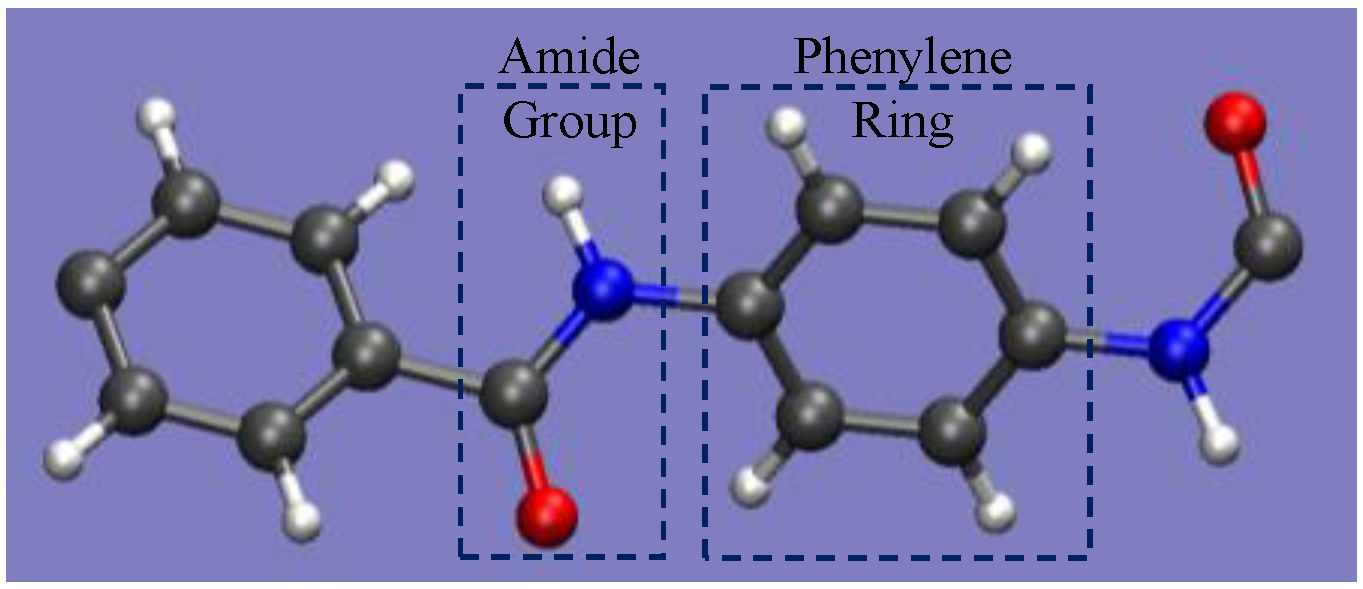


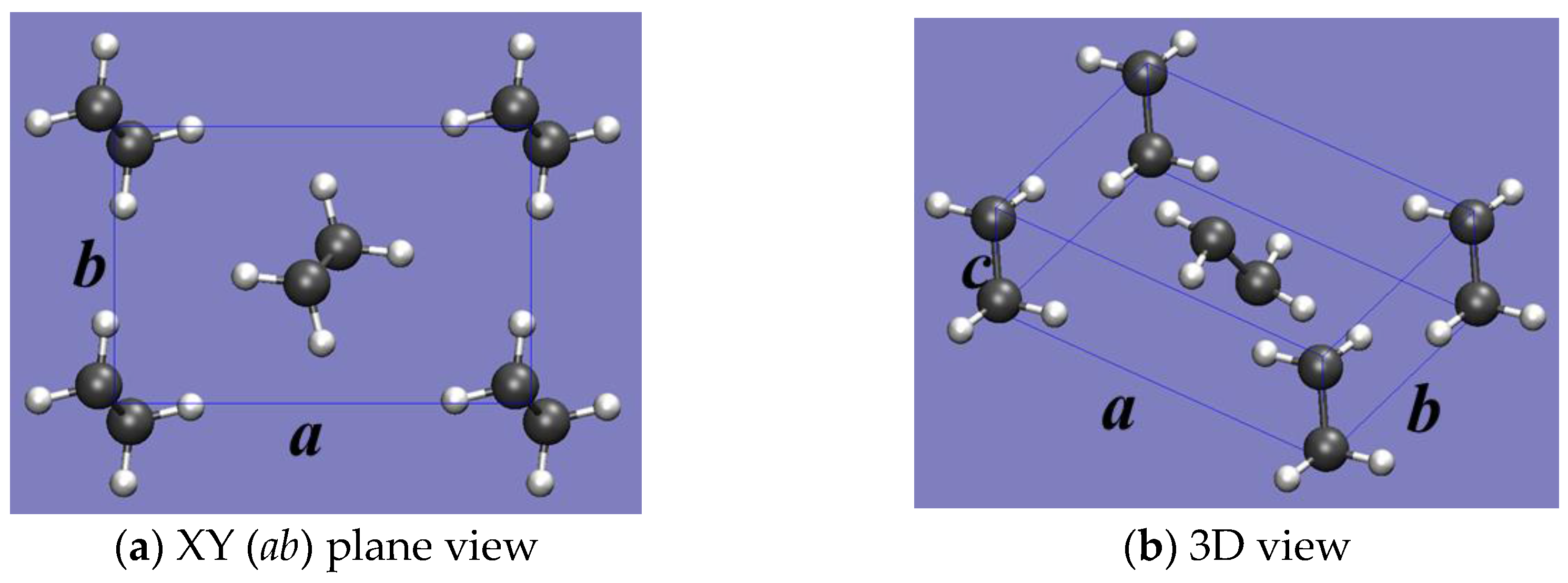
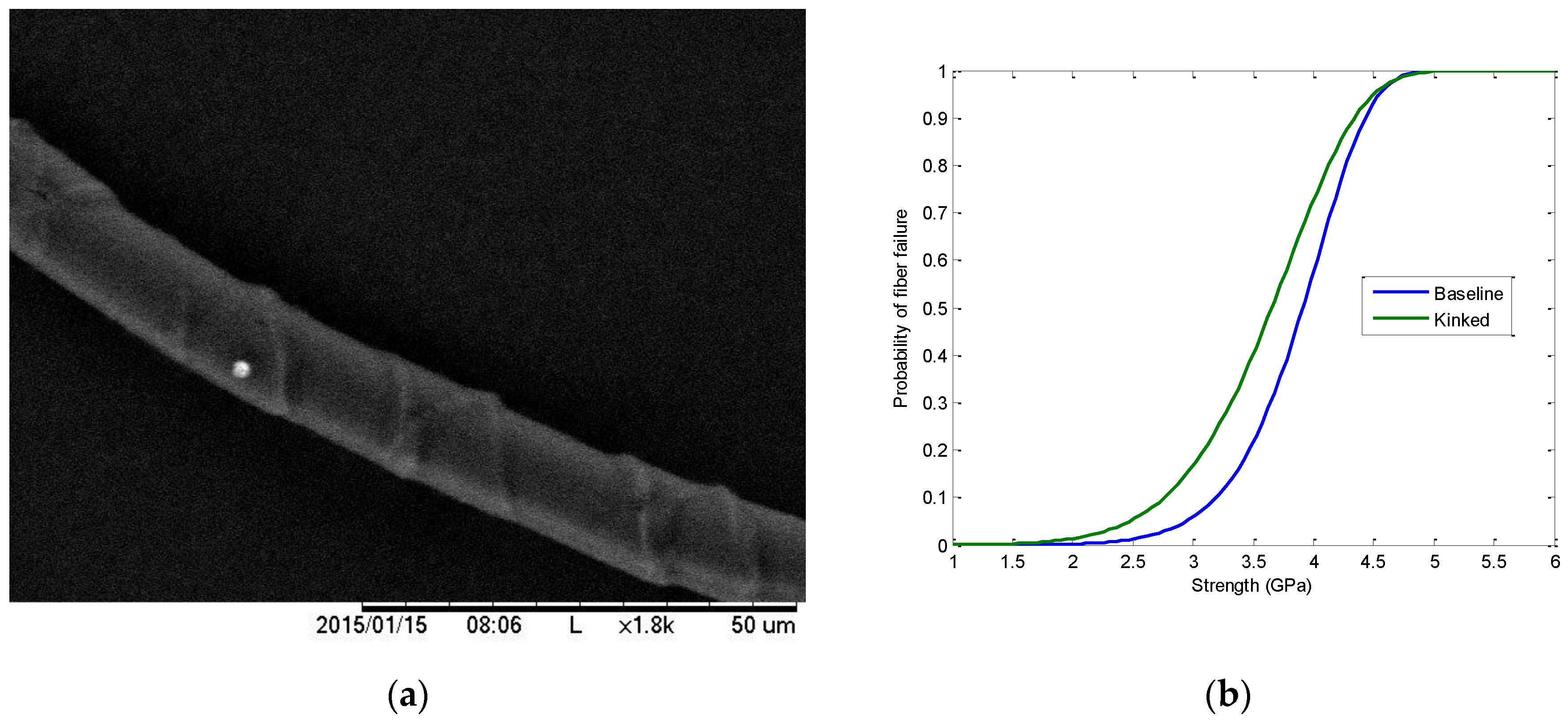
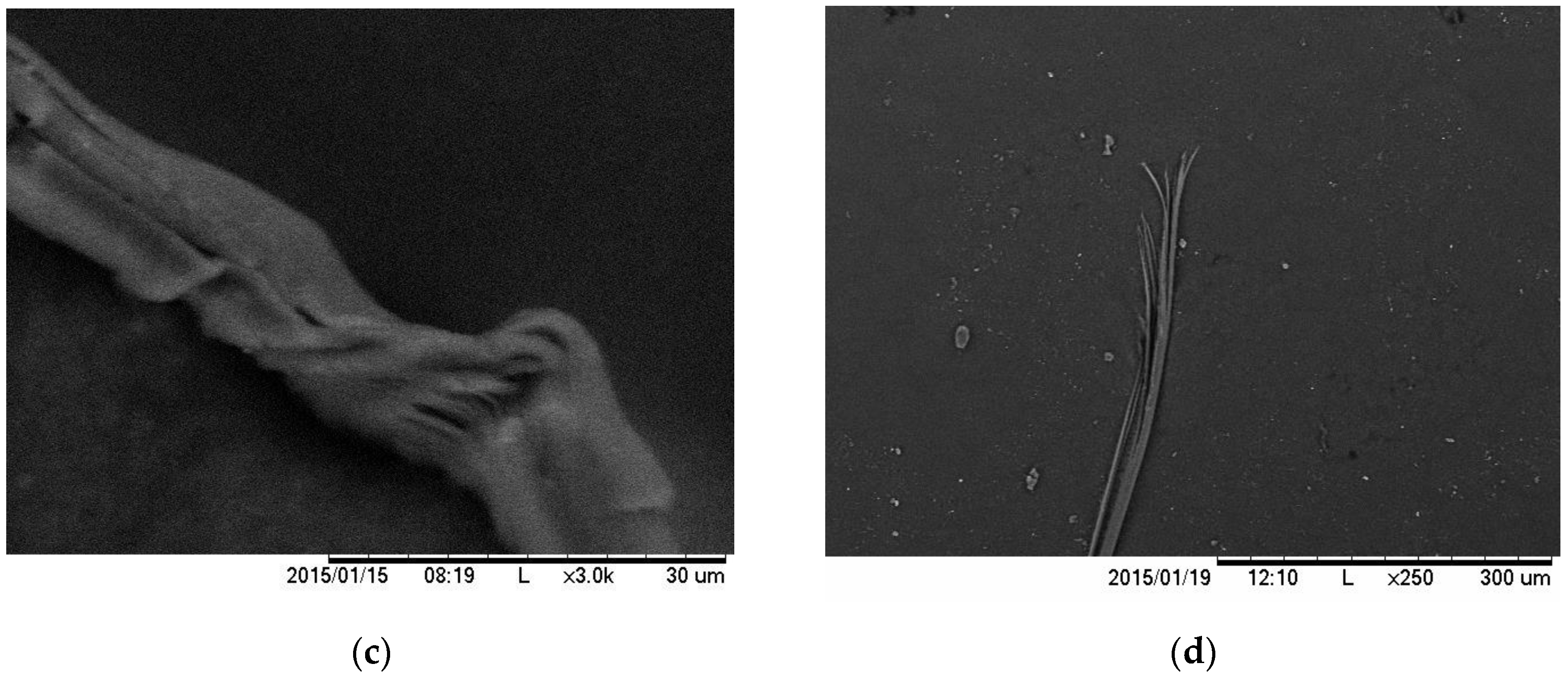
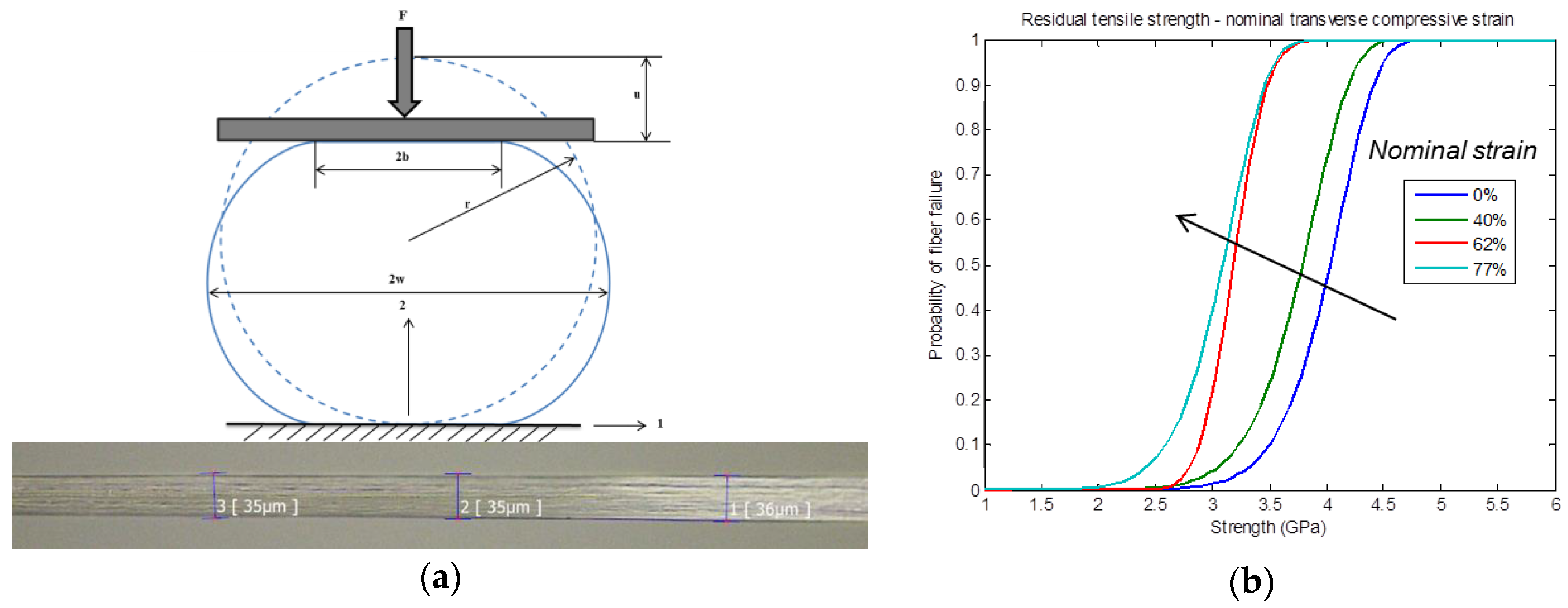

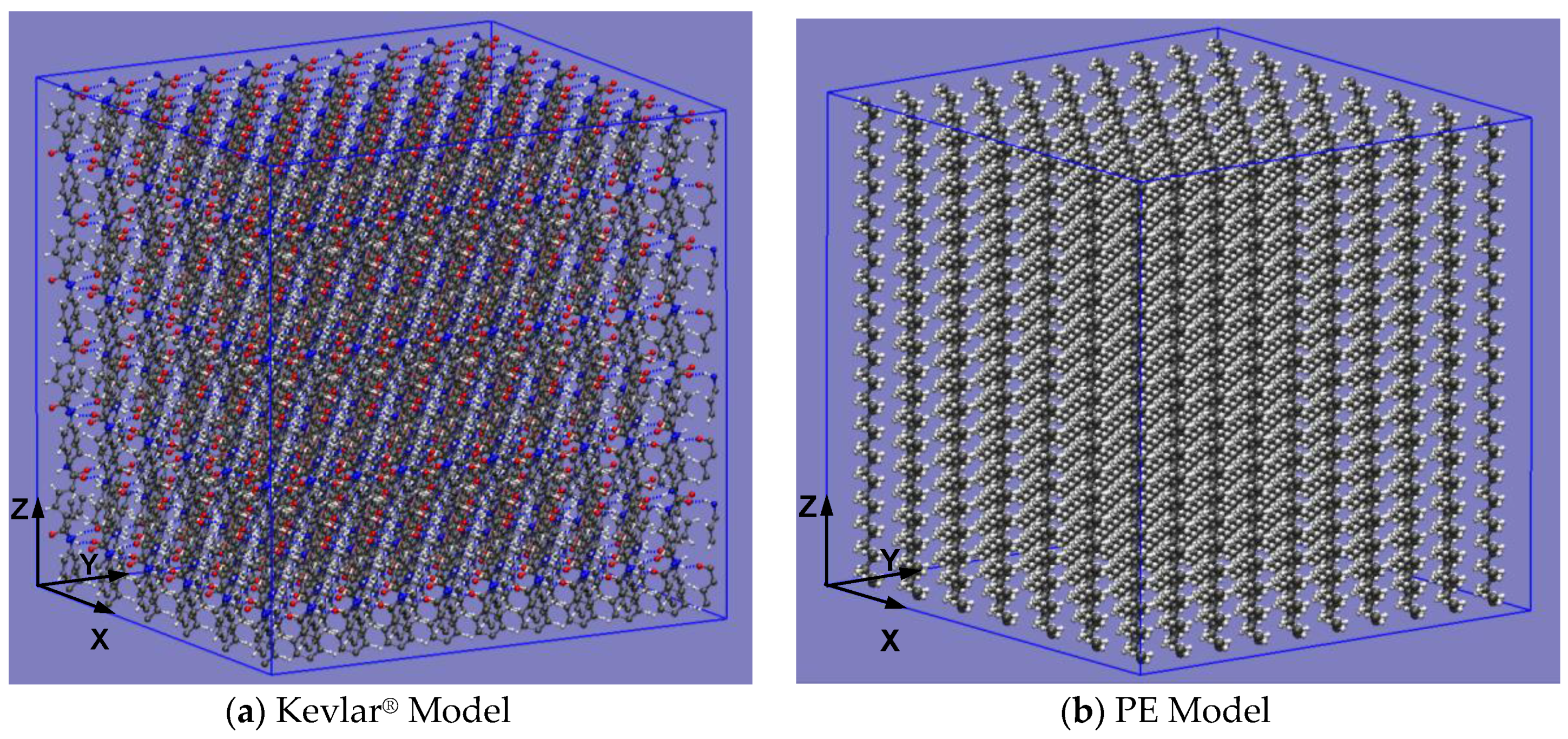

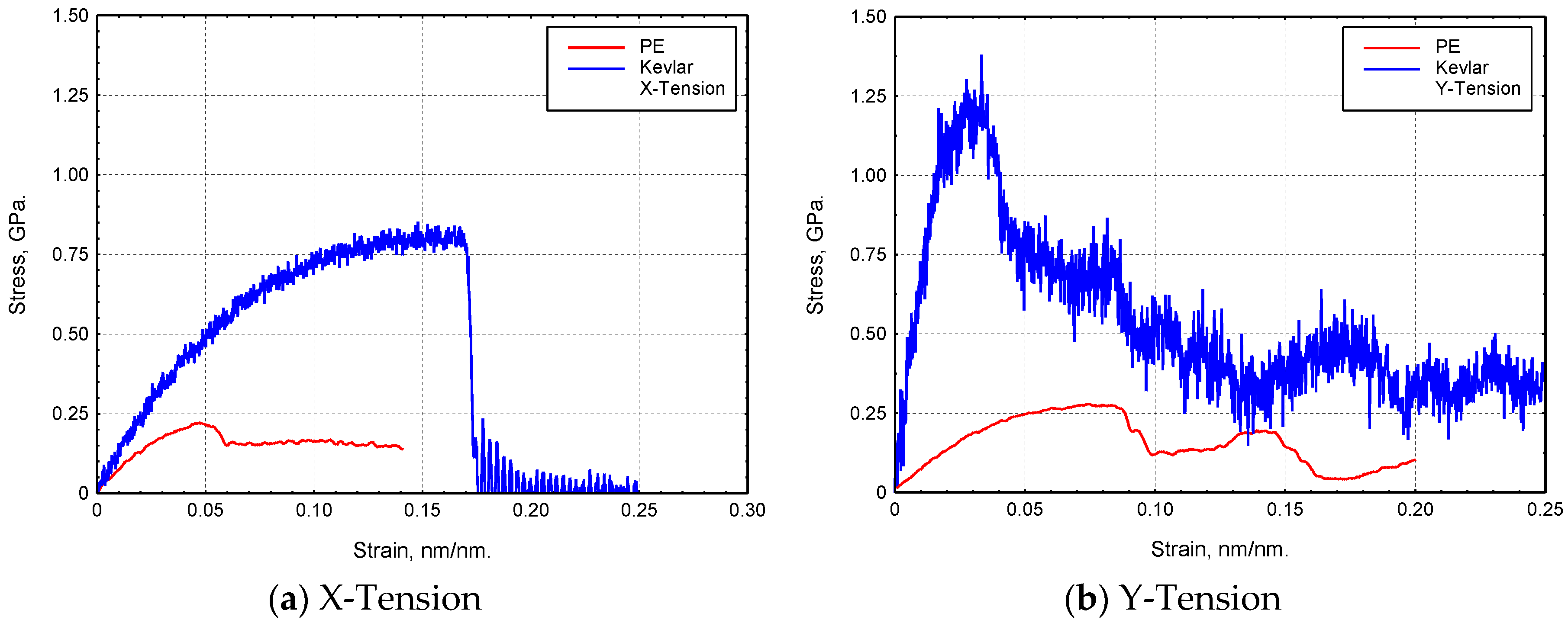
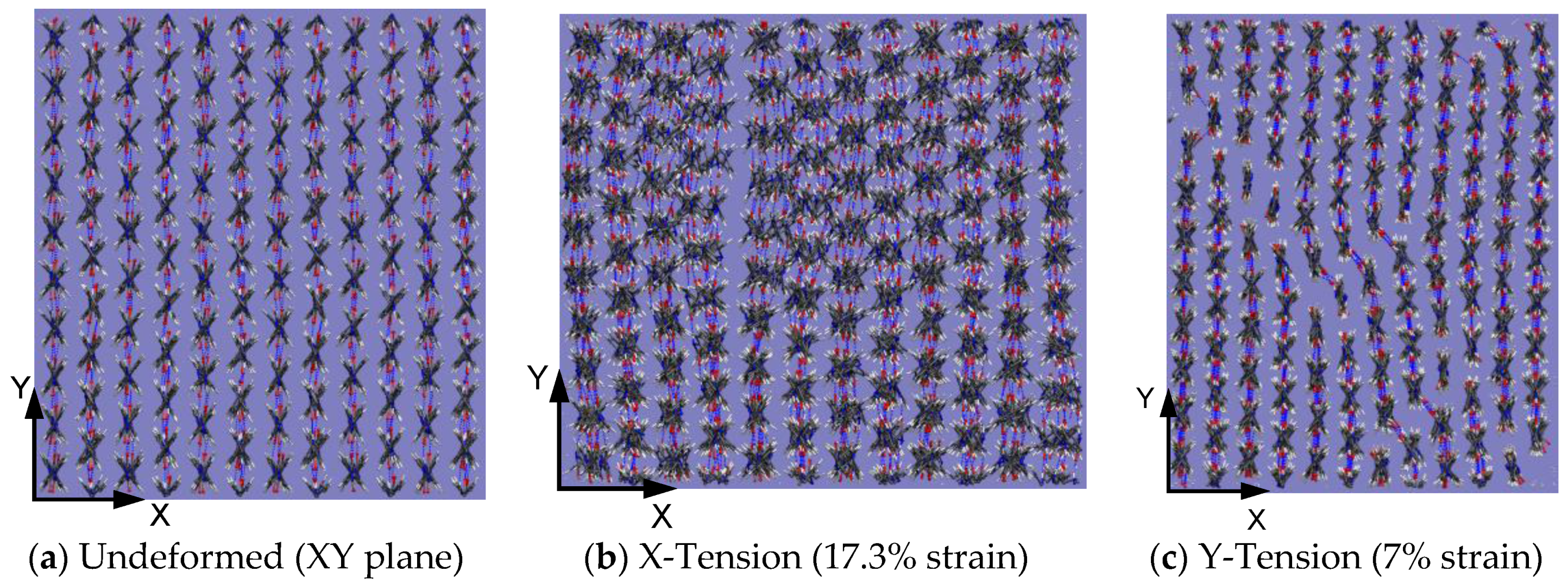
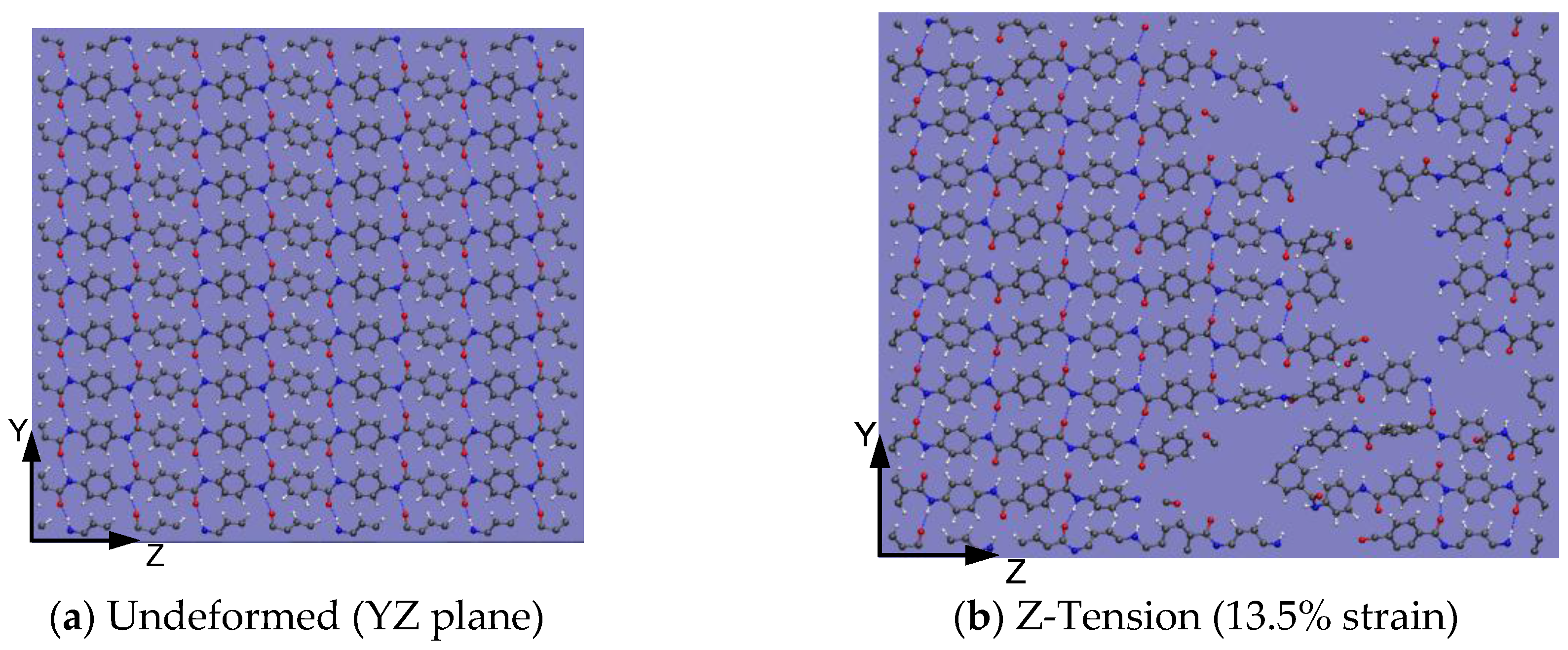
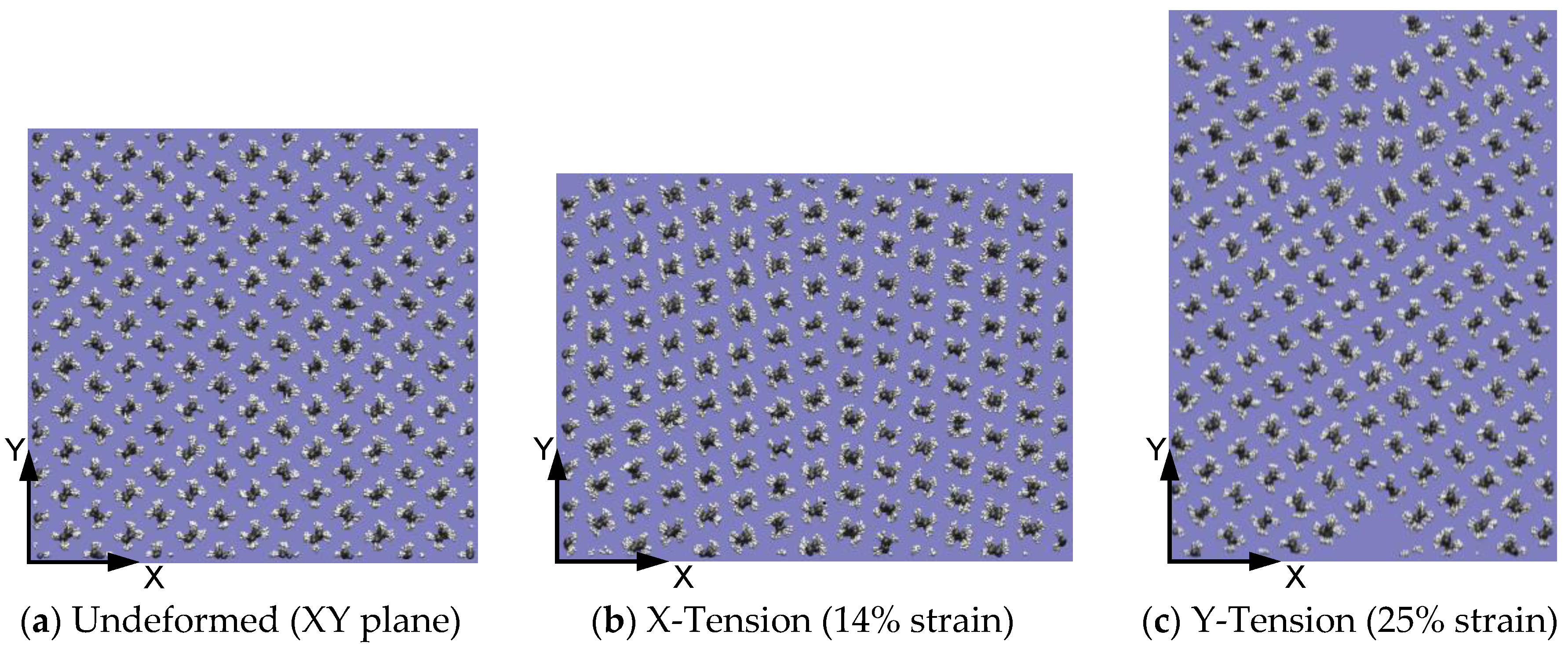
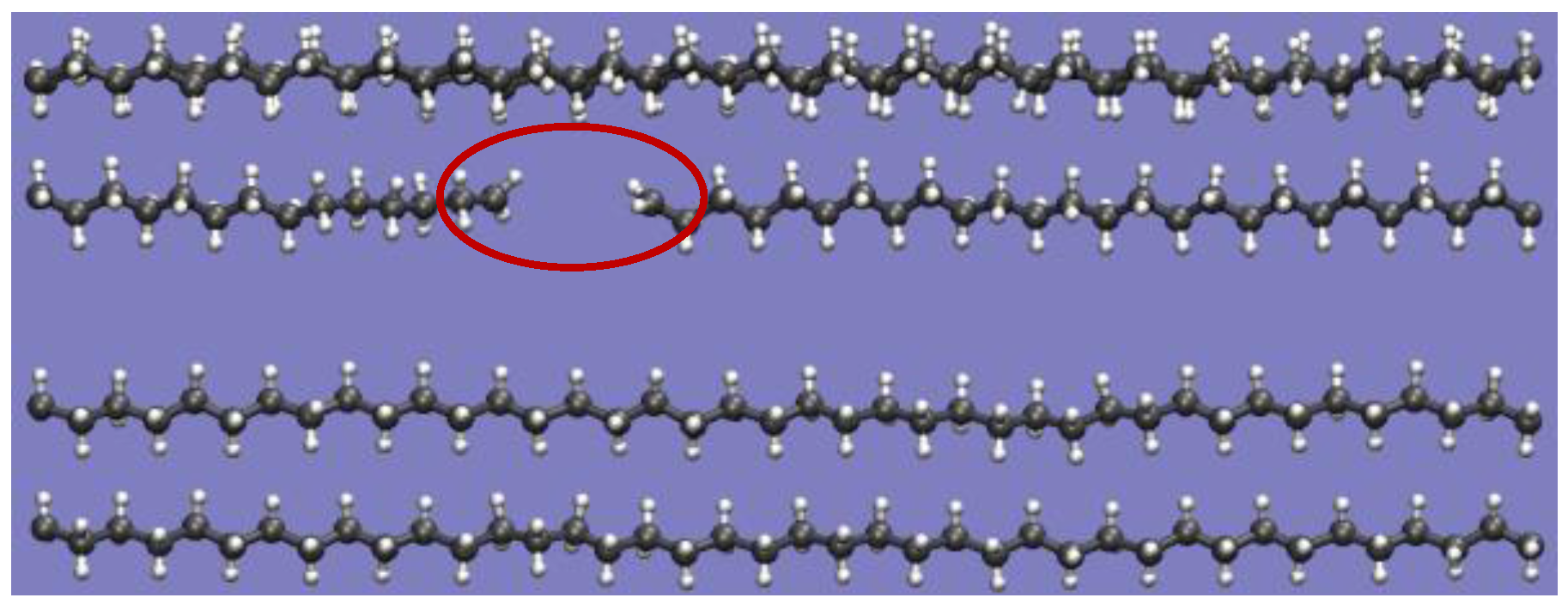
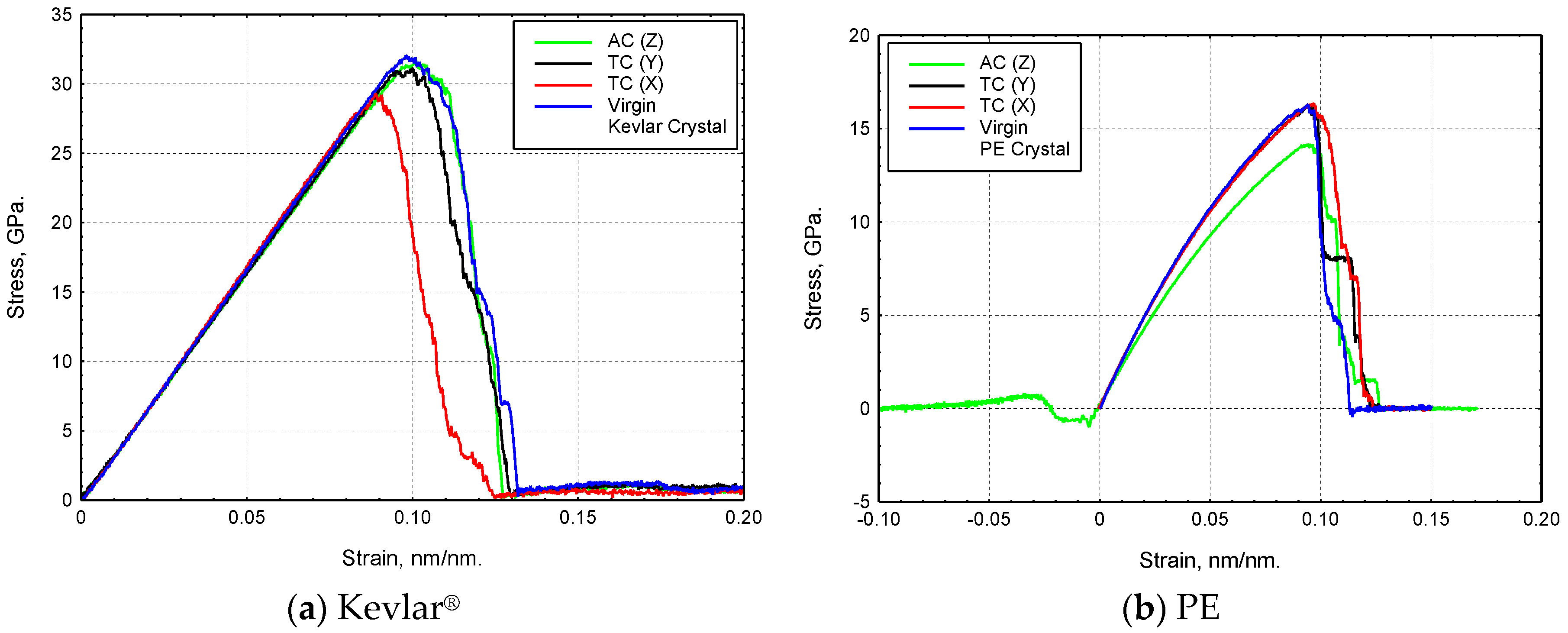
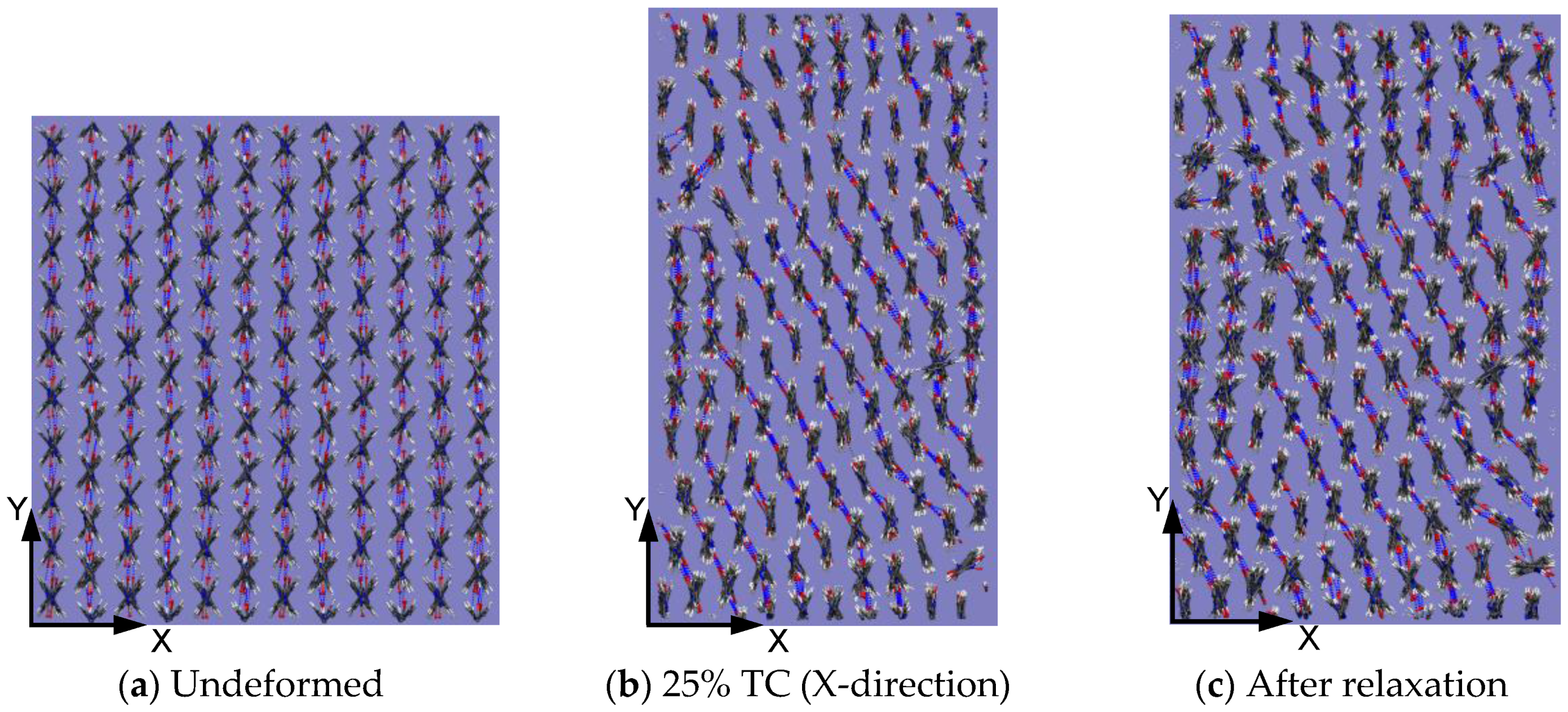

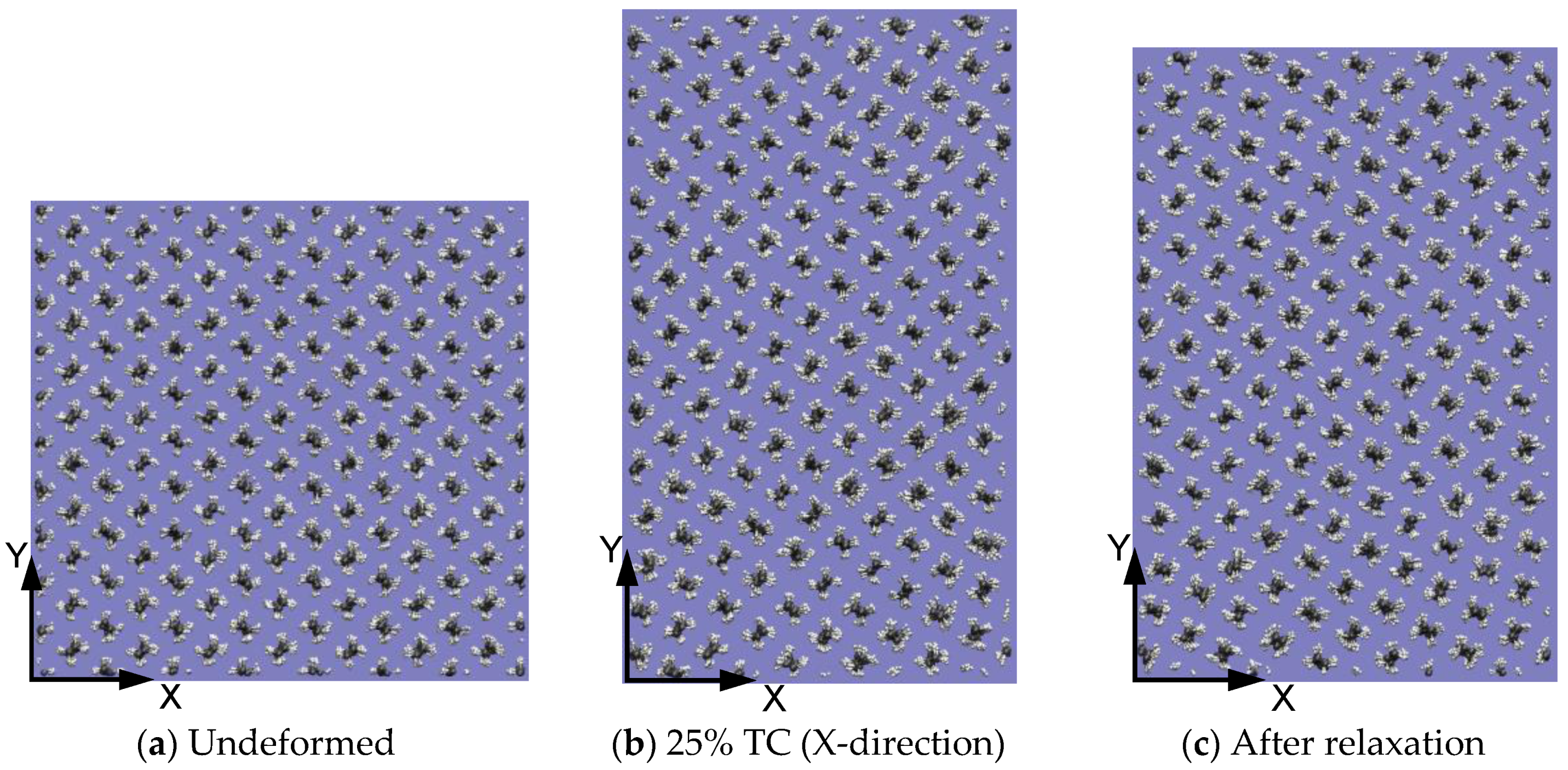

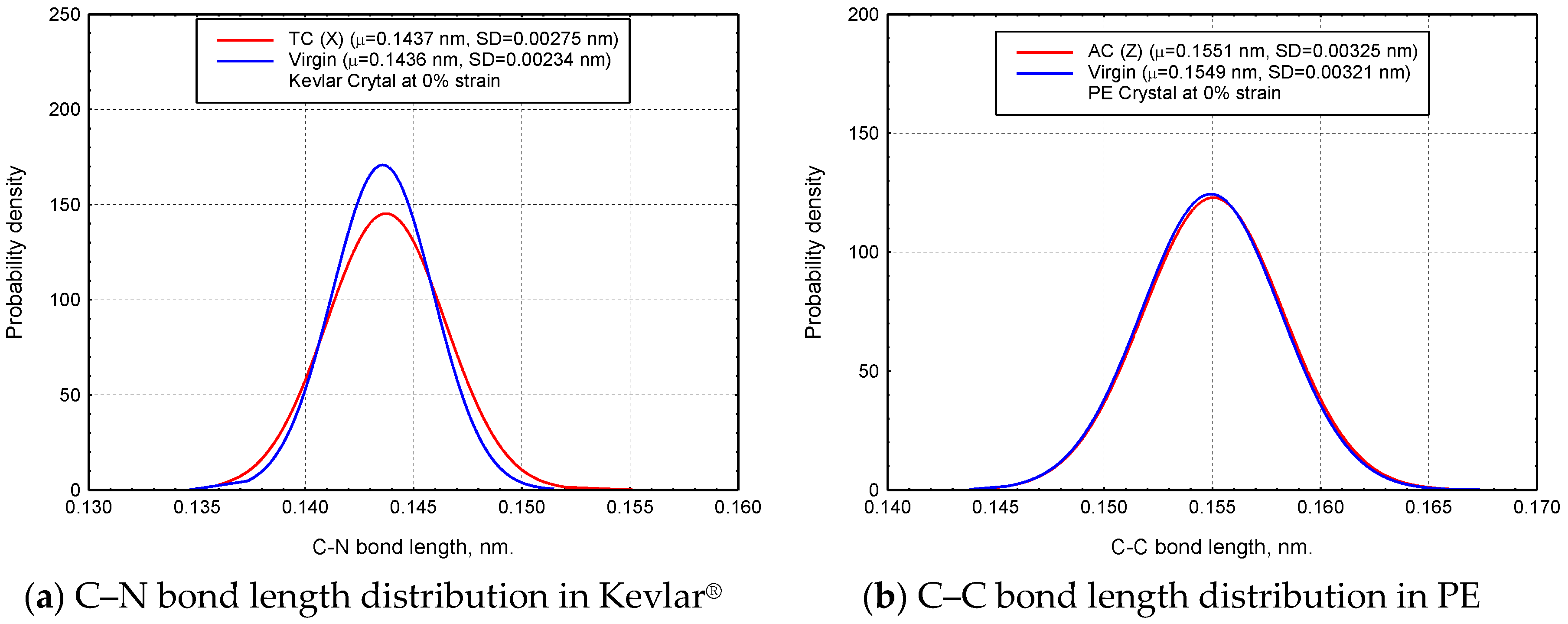
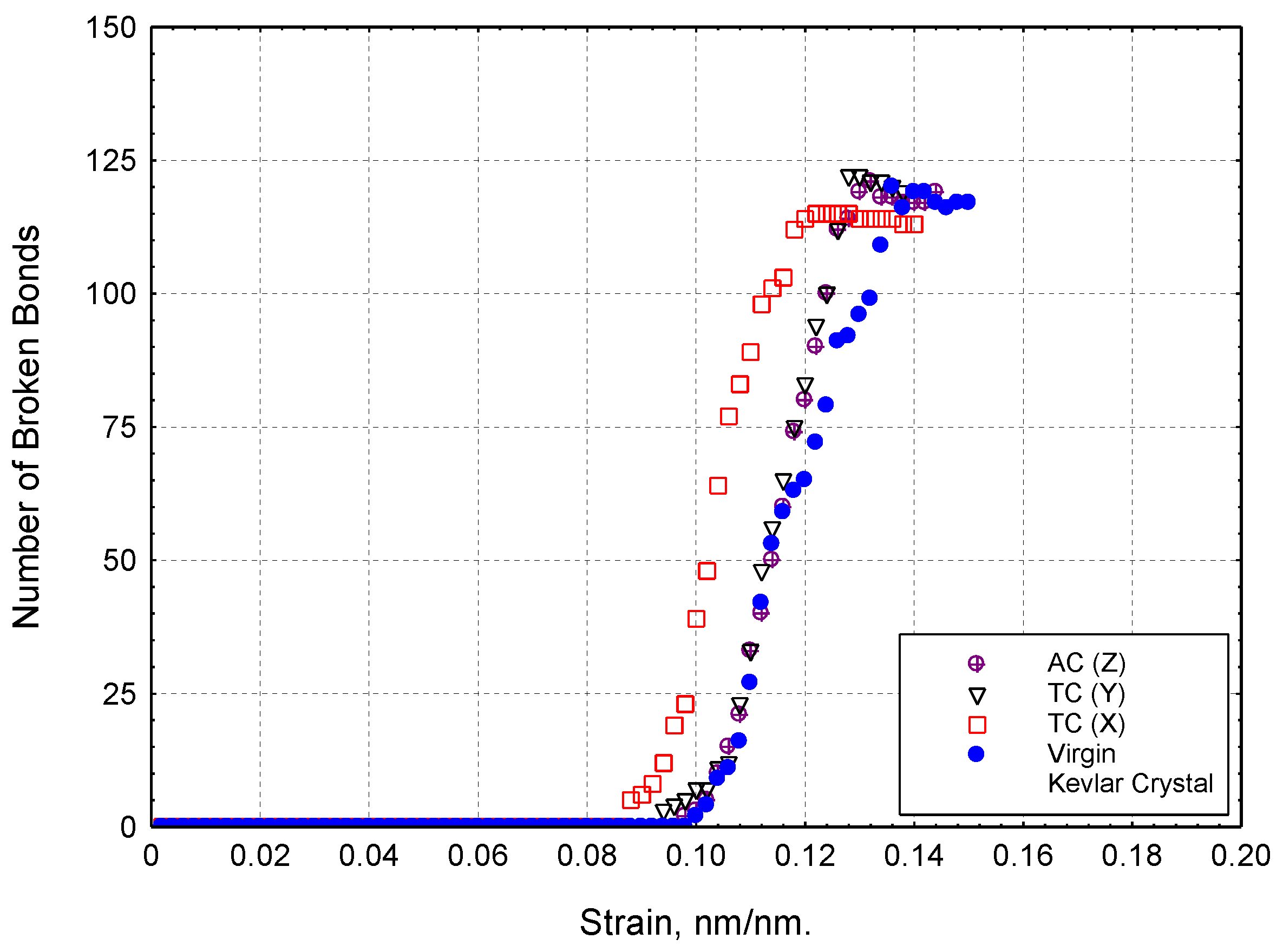
| Fiber Types | Scale Parameter (σ0) | Shape Parameter (m) | Location Parameter (γ) |
|---|---|---|---|
| Baseline fibers | 5.31 | 12.54 | −1.24 |
| Kinked fibers | 4.55 | 8.20 | −0.69 |
| Models | Modulus (GPa) | Strength (GPa) | ||||
|---|---|---|---|---|---|---|
| X-Direction | Y-Direction | Z-Direction | X-Direction | Y-Direction | Z-Direction | |
| Kevlar® | 12.0 | 74.0 | 325.0 | 0.80 | 1.19 | 31.90 |
| PE | 6.4 | 6.7 | 257.0 | 0.23 | 0.28 | 15.90 |
© 2017 by the authors. Licensee MDPI, Basel, Switzerland. This article is an open access article distributed under the terms and conditions of the Creative Commons Attribution (CC BY) license ( http://creativecommons.org/licenses/by/4.0/).
Share and Cite
Chowdhury, S.C.; Sockalingam, S.; Gillespie, J.W. Molecular Dynamics Modeling of the Effect of Axial and Transverse Compression on the Residual Tensile Properties of Ballistic Fiber. Fibers 2017, 5, 7. https://doi.org/10.3390/fib5010007
Chowdhury SC, Sockalingam S, Gillespie JW. Molecular Dynamics Modeling of the Effect of Axial and Transverse Compression on the Residual Tensile Properties of Ballistic Fiber. Fibers. 2017; 5(1):7. https://doi.org/10.3390/fib5010007
Chicago/Turabian StyleChowdhury, Sanjib C., Subramani Sockalingam, and John W. Gillespie. 2017. "Molecular Dynamics Modeling of the Effect of Axial and Transverse Compression on the Residual Tensile Properties of Ballistic Fiber" Fibers 5, no. 1: 7. https://doi.org/10.3390/fib5010007






